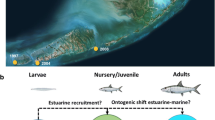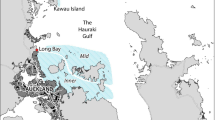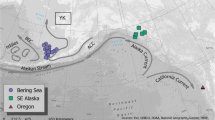Abstract
Japanese Spanish mackerel, Scomberomorus niphonius, is a commercially important, highly migratory species that is widely distributed throughout the northwestern Pacific region. However, its life history and migratory patterns are only partially understood. This study used otolith chemistry to investigate the migratory pattern of S. niphonius in the southern Yellow Sea, an important fishing ground. Transverse sections of otoliths from 15 age-1 spawning or spent individuals, comprising up to one complete migration cycle, were analyzed from the core to the margin by using laser ablation inductively coupled plasma mass spectrometry. The ratios of the element to Ca were integrated with microstructural analysis to produce age-related elemental profiles. Combining multielemental analysis of otolith composition with multivariate analytical models, we quantified structural changes in otolith chemistry profiles. Results revealed there were diverse changing patterns of otolith chemistry profiles for detected elements and the elements of Na, Mg, Sr and Ba were important for the chronological signal. Five clusters were identified through chronological clustering, representing the five life stages from the early stage to the spawning stage. Variation of Ba:Ca ratio was most informative, showing a step-decreasing pattern in the first four stages and a rebound in the spawning stage. These results support the hypothesized migratory pattern of S. niphonius: hatching and spending their early life in the coastal sandy ridges system of the southern Yellow Sea, migrating northeastward and offshore for feeding during juvenile stage, aggregating in early October and migrating outward to the Jeju Island for wintering, and returning to the coastal waters for spawning. This study demonstrated the value of life-history related otolith chemistry profiles combined with multivariate analytical models was a means to verify the migration patterns of S. niphonius at regional scales with potential application in fisheries assessment and management.
Similar content being viewed by others
References
Amano Y, Kuwahara M, Takahashi T, et al. 2013. Otolith elemental and Sr isotopic composition as a natal tag for Biwa salmon Oncorhynchus masou subsp. in Lake Biwa, Japan. Aquatic Biology, 19(1): 85–95, doi: https://doi.org/10.3354/ab00520
Bath G E, Thorrold S R, Jones C M, et al. 2000. Strontium and barium uptake in aragonitic otoliths of marine fish. Geochimica et Cosmochimica Acta, 64(10): 1705–1714, doi: https://doi.org/10.1016/S0016-7037(99)00419-6
Borcard D, Gillet F, Legendre P. 2011. Spatial analysis of ecological data. In: Borcard D, Gillet F, Legendre P, eds. Numerical Ecology with R. New York: Springer, 227–292
Breiman L, Friedman J H, Olshen R A, et al. 1984. Classification and regression trees. Biometrics, 40(3): 874
Brown R J, Severin K P. 2009. Otolith chemistry analyses indicate that water Sr:Ca is the primary factor influencing otolith Sr:Ca for freshwater and diadromous fish but not for marine fish. Canadian Journal of Fisheries and Aquatic Sciences, 66(10): 1790–1808, doi: https://doi.org/10.1139/F09-112
Campana S E. 1999. Chemistry and composition of fish otoliths: pathways, mechanisms and applications. Marine Ecology Progress Series, 188: 263–297, doi: https://doi.org/10.3354/meps188263
Campana S E, Thorrold S R. 2001. Otoliths, increments, and elements: keys to a comprehensive understanding of fish populations?. Canadian Journal of Fisheries Aquatic Science, 58(1): 30–38, doi: https://doi.org/10.1139/f00-177
Chan P, Halfar J, Williams B, et al. 2011. Freshening of the Alaska Coastal Current recorded by coralline algal Ba/Ca ratios. Journal Geophysical Research: Biogeosciences, 116(G1): 1387–1387
Cheung W W, Watson R, Pauly D. 2013. Signature of ocean warming in global fisheries catch. Nature, 497(7449): 365–368, doi: https://doi.org/10.1038/nature12156
Chittaro P M, Usseglio P, Fryer B J, et al. 2006. Spatial variation in otolith chemistry of Lutjanus apodus at Turneffe Atoll, Belize. Estuarine, Coastal and Shelf Science, 67(4): 673–680, doi: https://doi.org/10.1016/j.ecss.2005.12.014
De’ath G. 2002. Multivariate regression trees: a new technique for modeling species-environment relationships. Ecology, 83(4): 1105–1117
Edmonds J S, Caputi N, Morita M. 1991. Stock discrimination by trace-element analysis of otoliths of Orange Roughy (Hoplostethus atlanticus), a deep-water marine teleost. Australian Journal of Marine and Freshwater Research, 42(4): 383–389, doi: https://doi.org/10.1071/MF9910383
Elsdon T S, Gillanders B M. 2003. Reconstructing migratory patterns of fish based on environmental influences on otolith chemistry. Reviews in Fish Biology and Fisheries, 13(3): 217–235, doi: https://doi.org/10.1023/B:RFBF.0000033071.73952.40
Elsdon T S, Gillanders B M. 2004. Fish otolith chemistry influenced by exposure to multiple environmental variables. Journal of Experimental Marine Biology and Ecology, 313(2): 269–284, doi: https://doi.org/10.1016/j.jembe.2004.08.010
Elsdon T S, Wells B K, Campana S E, et al. 2008. Otolith chemistry to describe movements and life-history parameters of fishes: hypotheses, assumptions, limitations and inferences. Oceanography and Marine Biology: An Annual Review, 46(1): 297–330
Fablet R, Daverat F, De Pontual H. 2007. Unsupervised Bayesian reconstruction of individual life histories from otolith signatures: case study of Sr:Ca transects of European eel (Anguilla anguilla) otoliths. Canadian Journal of Fisheries and Aquatic Sciences, 64(1): 152–165, doi: https://doi.org/10.1139/f06-173
Fujiwara K, Satou S, Tojima T, et al. 2013. Maturity and spawning of female Spanish mackerel Scomberomorus niphonius in the Sea of Japan. Bulletin of Kyoto Prefectural Agriculture (in Japanese), 25: 13–18
Gemperline P J, Rulifson R A, Paramore L. 2002. Multi-way analysis of trace elements in fish otoliths to track migratory patterns. Chemometrics and Intelligent Laboratory Systems, 58(1–2): 135–146
Gillanders B M. 2005. Otolith chemistry to determine movements of diadromous and freshwater fish. Aquatic Living Resources, 18(3): 291–300, doi: https://doi.org/10.1051/alr:2005033
Gillanders B M, Kingsford M J. 2003. Spatial variation in elemental composition of otoliths of three species of fish (family Sparidae). Estuarine, Coastal and Shelf Science, 57(5–6): 1049–1064
Gower J C. 1966. Some distance properties of latent root and vector methods used in multivariate analysis. Biometrika, 53(3–4): 325–338
Grammer G L, Morrongiello J R, Izzo C, et al. 2017. Coupling biogeochemical tracers with fish growth reveals physiological and environmental controls on otolith chemistry. Ecological Monographs, 87(3): 487–507, doi: https://doi.org/10.1002/ecm.1264
Hedger R D, Atkinson P M, Thibault I, et al. 2008. A quantitative approach for classifying fish otolith strontium: calcium sequences into environmental histories. Ecological Informatics, 3(3): 207–217, doi: https://doi.org/10.1016/j.ecoinf.2008.04.001
Hicks A S, Closs G P, Swearer S E. 2010. Otolith microchemistry of two amphidromous galaxiids across an experimental salinity gradient: a multi-element approach for tracking diadromous migrations. Journal of Experimental Marine Biology and Ecology, 394(1–2): 86–97
Horikawa H, Zheng Y, Meng T. 2001. Biological and Ecological Characteristics of Valuable Fisheries Resources from the East China Sea and the Yellow Sea—Comparison between the Chinese and Japanese Knowledge. Nagasaki, Japan: Seikai National Fisheries Research Institute
Huh S H, Park J M, Baeck G W. 2006. Feeding habits of spanish mackerel (Scomberomorus niphonius) in the southern sea of Korea. Korean Journal of Fisheries and Aquatic Sciences, 39(1): 35–41, doi: https://doi.org/10.5657/kfas.2006.39.1.035
Inoue T, Wada Y, Tojima T, et al. 2007. Age and migration of the Japanese Spanish Mackerel (Scomberomorus niphonius) in the coastal waters of Kyoto Prefecture. Bulletin of the Kyoto Institute of Oceanic & Fishery Science, 29: 1–6
Izzo C, Reis-Santos P, Gillanders B M. 2018. Otolith chemistry does not just reflect environmental conditions: A meta-analytic evaluation. Fish and Fisheries, 19(3): 441–454, doi: https://doi.org/10.1111/faf.12264
Jiang Tao, Liu Hongbo, Lu Mingjie, et al. 2016. A Possible connectivity among estuarine tapertail anchovy (Coilia nasus) populations in the Yangtze River, Yellow Sea, and Poyang Lake. Estuaries and Coasts, 39(6): 1762–1768, doi: https://doi.org/10.1007/s12237-016-0107-z
Kalish J M. 1991. Oxygen and carbon stable isotopes in the otoliths of wild and laboratory-reared Australian salmon (Arripis trutta). Marine Biology, 110(1): 37–47, doi: https://doi.org/10.1007/BF01313090
Kim H, Lim Y N, Song S H, et al. 2016. Understanding the migration path of Spanish mackerel Scomberomorus niphonius using catch distributions. Korean Journal of Fisheries and Aquatic Sciences, 49(3): 376–384, doi: https://doi.org/10.5657/KFAS.2016.0376
Lea D W, Boyle E A. 1991. Barium in planktonic foraminifera. Geochimica et Cosmochimica Acta, 55(11): 3321–3331, doi: https://doi.org/10.1016/0016-7037(91)90491-M
Liang Cui, Pauly D. 2017. Fisheries impacts on China’s coastal ecosystems: Unmasking a pervasive ‘fishing down’ effect. PLoS One, 12(3): e0173296, doi: https://doi.org/10.1371/journal.pone.0173296
Liu Chanxin, Yang Kaiwen. 1982. Studies on the growth of Spanish mackerel, Scomberomorus niphonius in the Huanghai Sea and Bohai Sea. Oceanologia et Limnologia Sinica (in Chinese), 13(2): 170–178
Lü Xinguang, Qiao Fangli, Xia Changshui, et al. 2006. Upwelling off Yangtze River estuary in summer. Journal of Geophysical Research: Oceans, 111(C11): C11S08
Ma Shuyang, Cheng Jiahua, Li Jianchao, et al. 2019. Interannual to decadal variability in the catches of small pelagic fishes from China Seas and its responses to climatic regime shifts. Deep Sea Research Part II: Topical Studies in Oceanography, 159: 112–129, doi: https://doi.org/10.1016/j.dsr2.2018.10.005
Masuda R, Shoji J, Nakayama S, et al. 2003. Development of schooling behavior in Spanish mackerel Scomberomorus niphonius during early ontogeny. Fisheries Science, 69(4): 772–776, doi: https://doi.org/10.1046/j.1444-2906.2003.00685.x
Mercier L, Darnaude A M, Bruguier O, et al. 2011. Selecting statistical models and variable combinations for optimal classification using otolith microchemistry. Ecological Applications, 21(4): 1352–1364, doi: https://doi.org/10.1890/09-1887.1
Pang Yumeng, Tian Yongjun, Fu Caihong, et al. 2018. Variability of coastal cephalopods in overexploited China Seas under climate change with implications on fisheries management. Fisheries Research, 208: 22–33, doi: https://doi.org/10.1016/j.fishres.2018.07.004
Qiu Shengyao, Ye Maozhong. 1996. Studies on the reproductive biology of Scomberomorus niphonius in the Yellow Sea and Bohai Sea. Oceanologia et Limnologia Sinica (in Chinese), 27(5): 463–470
R Development Core Team. 2013. R: A language and environment for statistical computing. Vienna, Austria: R Foundation for Statistical Computing
Secor D H, Dean J M, Campana S E. 1995a. Recent Developments in Fish Otolith Research. Columbia, SC: University of South Carolina Press
Secor D H, Henderson-Arzapalo A, Piccoli P M. 1995b. Can otolith microchemistry chart patterns of migration and habitat utilization in anadromous fishes?. Journal of Experimental Marine Biology and Ecology, 192(1): 15–33, doi: https://doi.org/10.1016/0022-0981(95)00054-U
Shoji J, Maehara T, Tanaka M. 1999. Short-term occurrence and rapid growth of Spanish mackerel larvae in the central waters of the Seto Inland Sea, Japan. Fishery Science, 65(1): 68–72, doi: https://doi.org/10.2331/fishsci.65.68
Shoji J, Tanaka M. 2005. Distribution, feeding condition, and growth of Japanese Spanish mackerel (Scomberomorus niphonius) larvae in the Seto Inland Sea. Fishery Bulletin, 103(2): 371–379
Shui Bonian, Han Zhiqiang, Gao Tianxiang, et al. 2009. Mitochondrial DNA variation in the East China Sea and Yellow Sea populations of Japanese Spanish mackerel Scomberomorus niphonius. Fisheries Science, 75(3): 593–600, doi: https://doi.org/10.1007/s12562-009-0083-3
Sturrock A M, Hunter E, Milton J A, et al. 2015. Quantifying physiological influences on otolith microchemistry. Methods in Ecology and Evolution, 6(7): 806–816, doi: https://doi.org/10.1111/2041-210X.12381
Sturrock A M, Trueman C N, Darnaude A M, et al. 2012. Can otolith elemental chemistry retrospectively track migrations in fully marine fishes?. Journal of Fish Biology, 81(2): 766–795, doi: https://doi.org/10.1111/j.1095-8649.2012.03372.x
Thibault I, Hedger R D, Dodson J J, et al. 2010. Anadromy and the dispersal of an invasive fish species (Oncorhynchus mykiss) in eastern Quebec, as revealed by otolith microchemistry. Ecology of Freshwater Fish, 19(3): 348–360, doi: https://doi.org/10.1111/J.1600-0633.2010.00417.x
Thresher R E. 1999. Elemental composition of otoliths as a stock delineator in fishes. Fisheries Research, 43(1–3): 165–204
Thresher R E, Proctor C, Gunn J S, et al. 1994. An evaluation of electron-probe microanalysis of otoliths for stock delineation and identification of nursery areas in a southern temperate ground-fish, Nemadactylus macropterus (Cheilodactylidae). Fishery Bulletin, 92(4): 817–840
Tian Yongjun, Kidokoro H, Watanabe T. 2006. Long-term changes in the fish community structure from the Tsushima warm current region of the Japan/East Sea with an emphasis on the impacts of fishing and climate regime shift over the last four decades. Progress in Oceanography, 68(2–4): 217–237
Uehara K, Saito Y. 2003. Late Quaternary evolution of the Yellow/East China Sea tidal regime and its impacts on sediments dispersal and seafloor morphology. Sedimentary Geology, 162(1–2): 25–38
Vignon M. 2015. Extracting environmental histories from sclerochronological structures—Recursive partitioning as a mean to explore multi-elemental composition of fish otolith. Ecological Informatics, 30: 159–169, doi: https://doi.org/10.1016/j.ecoinf.2015.10.002
Walther B D, Limburg K E. 2012. The use of otolith chemistry to characterize diadromous migrations. Journal of Fish Biology, 81(2): 796–825, doi: https://doi.org/10.1111/j.1095-8649.2012.03371.x
Walther B D, Thorrold S R. 2006. Water, not food, contributes the majority of strontium and barium deposited in the otoliths of a marine fish. Marine Ecology Progress Series, 311: 125–130, doi: https://doi.org/10.3354/meps311125
Wei Sheng. 1980. The fishing seasons and grounds of the blue spotted mackerel, Scomberomorus niphonius in the Yellow Sea and Bohai in relation to environmental factors. Transaction of Oceanology and Limnology (in Chinese), (2): 34–40
Wei Qinsheng, Yu Zhigang, Ran Xiangbin, et al. 2011. Characteristics of the western coastal current of the Yellow Sea and its impacts on material transportation. Advances in Earth Science (in Chinese), 26(2): 145–156
Yang Jian, Arai T, Liu Hongbo, et al. 2006. Reconstructing habitat use of Coilia mystus and Coilia ectenes of the Yangtze River estuary, and of Coilia ectenes of Taihu Lake, based on otolith strontium and calcium. Journal of Fish Biology, 69(4): 1120–1135, doi: https://doi.org/10.1111/j.1095-8649.2006.01186.x
Yin Yong, Zou Xinqin, Zhu Dakui, et al. 2008. Sedimentary facies of the central part of radial tidal sand ridge system of the eastern China coast. Frontiers of Earth Science in China, 2(4): 408–417, doi: https://doi.org/10.1007/s11707-008-0053-6
Yuan Yangyang, Ye Zhenjiang, Liu Qun, et al. 2009. Fishery oceanography and spatial-temporal distribution of Scomberomorus niphonius in spring in southern Yellow Sea. Oceanologia et Limnologia Sinica (in Chinese), 40(4): 506–510
Zhang Chi, Ye Zhenjiang, Li Zengguang, et al. 2016. Population structure of Japanese Spanish mackerel Scomberomorus niphonius in the Bohai Sea, the Yellow Sea and the East China Sea: evidence from random forests based on otolith features. Fisheries Science, 82(2): 251–256, doi: https://doi.org/10.1007/s12562-016-0968-x
Zhang Chi, Ye Zhenjiang, Panhwar S K, et al. 2013. Stock discrimination of the Japanese Spanish mackerel (Scomberomorus niphonius) based on the otolith shape analysis in the Yellow Sea and Bohai Sea. Journal of Applied Ichthyology, 29(2): 368–373, doi: https://doi.org/10.1111/jai.12084
Zhu Jianrong, Qi Dingman, Wu Hui. 2004. Observation and modeling analysis of dynamic mechanism of the upwelling at Lusi. Journal of East China Normal University (Natural Science) (in Chinese), (2): 87–91, 103
Acknowledgements
We thank all scientific staff and crew for their assistance with sample collection and experimental implementation. We thank Andrew Bakun (University of Miami) and Caihong Fu (Fisheries and Oceans Canada, Pacific Biological Station) for their valuable comments and proofreading.
Author information
Authors and Affiliations
Corresponding author
Additional information
Foundation item: The National Natural Science Foundation of China under contract Nos 41930534 and 41876177.
Rights and permissions
About this article
Cite this article
Pan, X., Ye, Z., Xu, B. et al. Combining otolith elemental signatures with multivariate analytical models to verify the migratory pattern of Japanese Spanish mackerel (Scomberomorus niphonius) in the southern Yellow Sea. Acta Oceanol. Sin. 39, 54–64 (2020). https://doi.org/10.1007/s13131-020-1606-0
Received:
Accepted:
Published:
Issue Date:
DOI: https://doi.org/10.1007/s13131-020-1606-0




